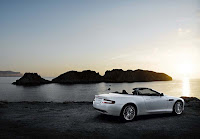Aston Martin Vantage GT4, 2009
The Aston Martin Racing has released the 2009 specification Aston Martin Vantage GT4 based on Aston Martin's new 4.7 litre Aston Martin V8 Vantage. The new Vantage GT4 builds on the success of its predecessor, the 4.3 litre Vantage N24.
The Aston Martin Vantage GT4 has been under development for six months and was unveiled in Dubai this week by Aston Martin chairman, David Richards, and tested extensively at the Dubai Autodrome.
The car is an evolution of the N24 with the larger capacity engine being more responsive with increased torque throughout the rev range. The suspension has been retuned to enhance the handling, including modified front uprights to give increased camber. The 2009 Aston Martin Vantage GT4 also has larger front brake discs with revised cooling.
The Aston Martin Vantage GT4 is built to FIA GT4 regulations and is eligible to compete in the following series: FIA GT4 European Cup; British GT4 Championship; Britcar Endurance Series; German GT4 Championship; Dutch Supercar Challenge; Dutch GT4 Championship; VLN Endurance Championship at the Nurburgring; Australian Endurance Championship; the American SCCA Championship; and the Aston Martin Owners Club Race Series.
The Aston Martin Vantage GT4 is based on the latest 4.7 litre V8 Vantage and is hand built by Aston Martin Racing. The 4.7 litre eight cylinder engine has an engine management system recalibrated for race use. It also has a free flow exhaust system and air filters, and the standard V8 dry sump lubrication system is retained, helping to prevent oil surge during cornering.
The Aston Martin Vantage GT4 can be supplied with either a six speed manual, or a Sportshift transmission with paddle controls. Both versions have a Valeo twin-plate cerametallic racing clutch and lightweight flywheel to complete the powertrain specification.
At 1,330 kg the Aston Martin Vantage GT4 is 300 kg lighter than the standard car. This has been achieved through a range of weight reduction measures. The interior trim is removed with the exception of the facia moulding, which is re-trimmed in Alcantara, and the console and door casings are replaced by new lightweight mouldings.
The chassis has been fitted with a high-strength steel rollcage and Recaro competition seats. A suede-trimmed steering wheel with a quick release mechanism is also fitted as standard. The Vantage GT4's safety features are completed with a Sabelt sixpoint safety harness with a push-button release and Lifeline Zero 360 gas extinguisher system.
The V8 Vantage road car's suspension has required only minor adjustments for optimal track performance. These include larger diameter front and rear anti-roll bars and adjustable ride height aluminium dampers, as well as single rate, flat ground springs with separate helper springs. The front subframe is modified for extra camber and castor. Cast magnesium front and rear wheels are standard fit with high performance Yokohama A048-R tyres. The brakes are uprated with Pagid RS 29 race pads.
As further endorsement of the standard V8 Vantage underframe, the active safety systems are directly carried over to the Aston Martin Vantage GT4, including: dynamic stability control, traction control, ABS and electronic brakeforce distribution, providing reassurance and enhanced control in slippery conditions.
The Aston Martin Vantage GT4 comes with either a manual or sportshift transmission. It is priced from £96,645 and is available to order now with delivery in January 2009.


























